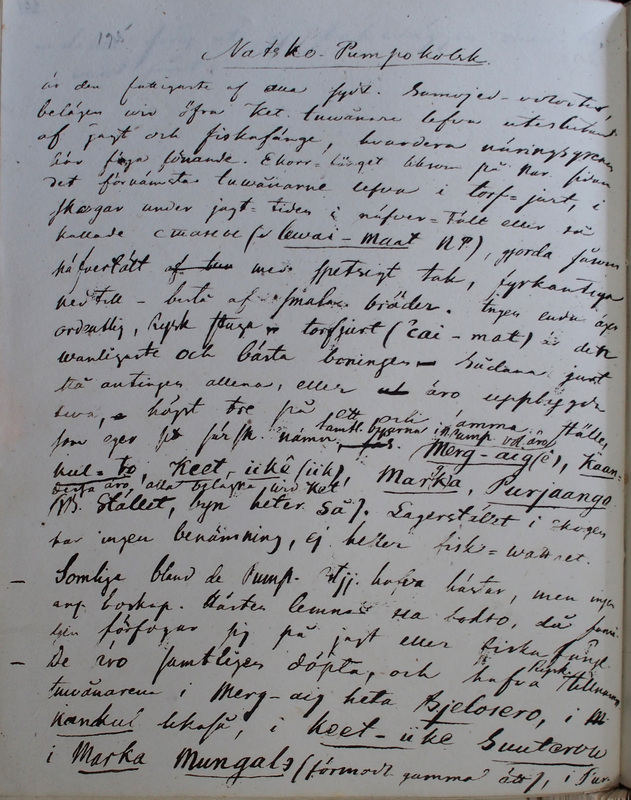Ethnographiska, historiska och statistiska anmärkningar. 222
Title
Ethnographiska, historiska och statistiska anmärkningar. 222
Description
|
Natsko-Pumpokolsk
The following four manuscript pages describe the so-called Nacko-Pumpokolʹsk Samoyed, a community of Selkups living on the upper reaches of the River Ket. Castrén visited the Nacko-Pumpokolʹsk Selkups in April 1846. The toponym Nacko-Pumpokolʹsk goes back to the Ostyak volosts of Nackaja and Pumpokolʹskaja, led by the princes of Jamak and Urnuk. For the linguistic notes, see [Manuscripta Castreniana Ostiak-Samoiedica.] (Miller 1941: 44; Castrén 1855: 145–147).
är den fattigaste af alla sydl. Samojed-voloster,
belägen vid öfva Ket. Tillwånare lefva uteslutande af jagt och fiskafånge,
hvardera näringsgrenenLiving in the West Siberian forest areas, fishing and hunting were the main sources of livelihood of the Selkups. In the northern living areas, small-scale reindeer herding, and in the southern ones horses and cattle formed additional sources of livelihood and means of transport. For an overview, see Golovnev & Tučkova 2005: 317–328.
hör föga lönande. Ekorr-fånget liksom på nor. sidan det förnämsta tillvånarne lefva i torf=jurt, i skogar under jagt=tiden i näfver-tält eller så kallade станы (lewas-Maat NP.),
gjorda såsomSE lewai-maat. See [MC Ostiak-Samoiedica’s vocabulary] For an overview of the Selkup dwellings, see Sokolova 1998: 21–26.
näfverstält af tun med spetsigt tak, fyrkantiga nedtill - bestå af smala brädor. Ingen enda äger ordentlig, Rysk stuga. Torfjurt (*cai-mat)
är detSE čai-mat. See [MC Ostiak-Samoiedica’s vocabulary] For an overview of the Selkup dwellings, see Sokolova 1998: 21–26.
wanligaste och bästa boningen - Sådana jurt stå antligen allena, eller äro uppbyggda två, högst tre på ett och samma ställe. |
Natsko-Pumpokolsk is the poorest of all the southern Samoyed Volosts, located on the upper reaches of the River Ket. The residents live exclusively from hunting and fishing, with each source of livelihood yielding little profit. Squirrel-hunting, as on the northern side. Most of the inhabitants live in peat yurts, in the forests, or during the hunting season in birch bark tents or so-called stany (lewas-Maat NP), made similarly to the birch bark tents, with a pointed roof, square at the bottom, consisting of narrow boards. No one owns a proper Russian cottage. A peat yurt (*cai-mat) is it the most common and the best dwelling. Such yurts stand either alone, or two side by side, with a maximum of three in one place. |
| Samtl.[Samtliga] byarna som eger sitt särsk. nämn i N. Pump. vol.[Natsko Pumpokolsk volosten] äro Merg-aig(é), Kaam kul=to, Keet-iikê(iik), Marg(k)a, Purjaango Dessa äro alla belägna vid Ket. |
The villages located in the Natsko Pumpokolsk volost that have their own names are Merg-aig (é), Kaam kul-to, Keet-iikê (iik), Marg (k) a, and Purjaango. These are all located on the Ket. |
| NB. Stället, byn heter så. Lagerstället i skogen har ingen benämning, ej heller fisk=wattnet. Somliga bland de Pump. Ostjj. [Pumpokolska Ostjakerna]
hafva hästar, men ingenThe Pumpokolʹsk Ostyaks refer to Kets who live as neighbours of the Selkups in the area. Ostyak was an exonym used by Russian colonists to refer to fishers and hunters, separating them from pastoralist reindeer herders. In other words, Ostyak does not refer here to an ethno-linguistic community.
ang. [angående] boskap. Hästen lemnas на волю, då som ligen förfogar sig på jagt eller fiskafånge. |
NB: A place, a village is named. A camp place in the forest has no name, and nor do fishing waters. Some among the Pumpokolsk Ostyaks have horses, but no cattle. The horses are left free when they devote themselves to hunting or fishing. |
| De äro samtligen döpta, och hafva Ryska tillnamn. Tillvånaren i Merg-aig heta Bjelosero, i Kankul likaså, i Keet-iike Suutorow i Marka Mungalэ (förmodt gammal). |
They are all baptised, and have Russian surnames. The residents of Merg-aig are called Bjelosero, as are the residents of Kankul. The residents of Keet-iike are called Suutorow and those of Marka Mungalэ (presumably old). |

